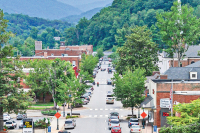Letting nature point the way
Horace Kephart is best known for Our Southern Highlanders (first published in 1913, with an expanded edition in 1922) and his role in helping to found the Great Smoky Mountains National Park. But he also published a book that is now recognized as one of the cornerstones of American outdoor literature, Camping and Woodcraft.
After moving to the Great Smokies, 20 years before the national park was founded, Kephart lived in a cabin on the Little Fork of the Sugar Fork of Hazel Creek from 1904 until 1907. From 1910 until his death in 1931, he resided in Bryson City.
During those years on Hazel Creek, he became preoccupied with living as efficiently as possible in a somewhat remote setting. Despite outdoor experiences dating back to childhood, he discovered that he now “had to make shift in a different way . . . seeking not novelties but practical results.” These “results” he published in outdoor magazines.
By 1906, he had compiled enough material to put together the first edition of The Book of Camping and Woodcraft; A Guidebook for Those Who Travel in the Wilderness, published by the Outing Publishing Company in New York. An expanded edition published in two separate volumes appeared in 1916 and 1917, respectively; and in 1921 it came out in a hefty “two volumes in one” format as Camping and Woodcraft: A Handbook for Vacation Campers and for Travelers in the Wilderness.
In the process of expansion and revision, the book became a compendium of anecdotes, recipes, adventures, and practical advice on tent camping, path finding, route sketching, bark utensils, knot tying, backcountry exploration, bee hunting, and more. It remains remarkably useful and is great fun to rummage around in on a rainy day.
I was recently doing just that when I happened upon a section that focused my attention. It is headed “Nature’s Guide-Posts.” Therein, Kephart notes that, “There are two questions that woodsmen will argue, I suppose, until doomsday. Having given my views on one of them I may as well tackle the other, and then have done with controversy. Are there any natural signs of direction that will give a man his bearings when the sky is obscured? . . . I shall endeavor to show that there is more in this matter than is generally credited.”
Related Items
After a lengthy digression regarding the pros and cons of the old notion that moss always on the north side of trees, Kephart turns his attention to “Tips of Conifers,” noting that, “A rule that holds good in the main, wherever I have had a chance to study it, that the feathery tip, the topmost little branch, of a towering pine or hemlock, points toward the rising sun, that is to say, a little south of east. There are exceptions, of course, but I have generally found this to be the case in three-fourths of the trees examined.” I suspect that the direction of the bend is random and that it is caused by perching birds more often than “the rising sun.”
About “Bark and Annual Rings,” he notes that, “The bark of old trees is generally thicker on the north and northeast sides than on the other sides. A more reliable indicator of direction, though one that a traveler seldom has opportunity to test, is the thickness of annual rings of wood growth, which is more pronounced on the north than on the south side of a tree.
The part that interests me concerns “Compass-Plants.” In that section he first notes that, “Some plants show a decided polarity in their habit of growth,” citing “compass-plant or rosin-weed” as his prime example.
“I have often used the compass-plant as a guide,” he recalls, “and never was led astray by it; in fact, the old settlers on the prairies, if they chanced to get lost on a dark night, would get their bearings by feeling the leaves of the compass-plant.
Now we get to Kephart’s (and my) mystery plant. I would very much like to hear from anyone who can identify the “north-and-south plant” he describes:
“But what think you of plant roots that persistently grow north and south? The woodsmen of the Great Smoky Mountains declare that there is a ‘north-and-south plant,’ as they call it, with two long roots that grow respectively north and south. Doctor
Davis of Ware’s [Wear’s] Valley, on the Tennessee side described it to me as follows: ‘It resembles wild verbena, grows thigh-high, is a rare plant, and generally is found in hollows on the south side of mountains in rocky neighborhoods, near trickling streams. Its leaf is serrated, 1.5 by 1 inch, or larger, with purple heart, yellow edges, and the rest a bright red. Its roots usually do grow north and south. The plant is one of the most valuable medicinally that I know of, particularly for syphilitic affections. I do not know it by any other name than the native one of North-and-South. I gather it when I can find it, and use it in my practice.’
“Many others have given me similar reports,” Kephart concludes. “I do not know the plant; have never hunted systematically for it.”
Any ideas?
George Ellison wrote the biographical introductions for the reissues of two Appalachian classics: Horace Kephart’s Our Southern Highlanders and James Mooney’s History, Myths, and Sacred Formulas of the Cherokees. In June 2005, a selection of his Back Then columns was published by The History Press in Charleston as Mountain Passages: Natural and Cultural History of Western North Carolina and the Great Smoky Mountains. Readers can contact him at P.O. Box 1262, Bryson City, N.C., 28713, or at This email address is being protected from spambots. You need JavaScript enabled to view it..









